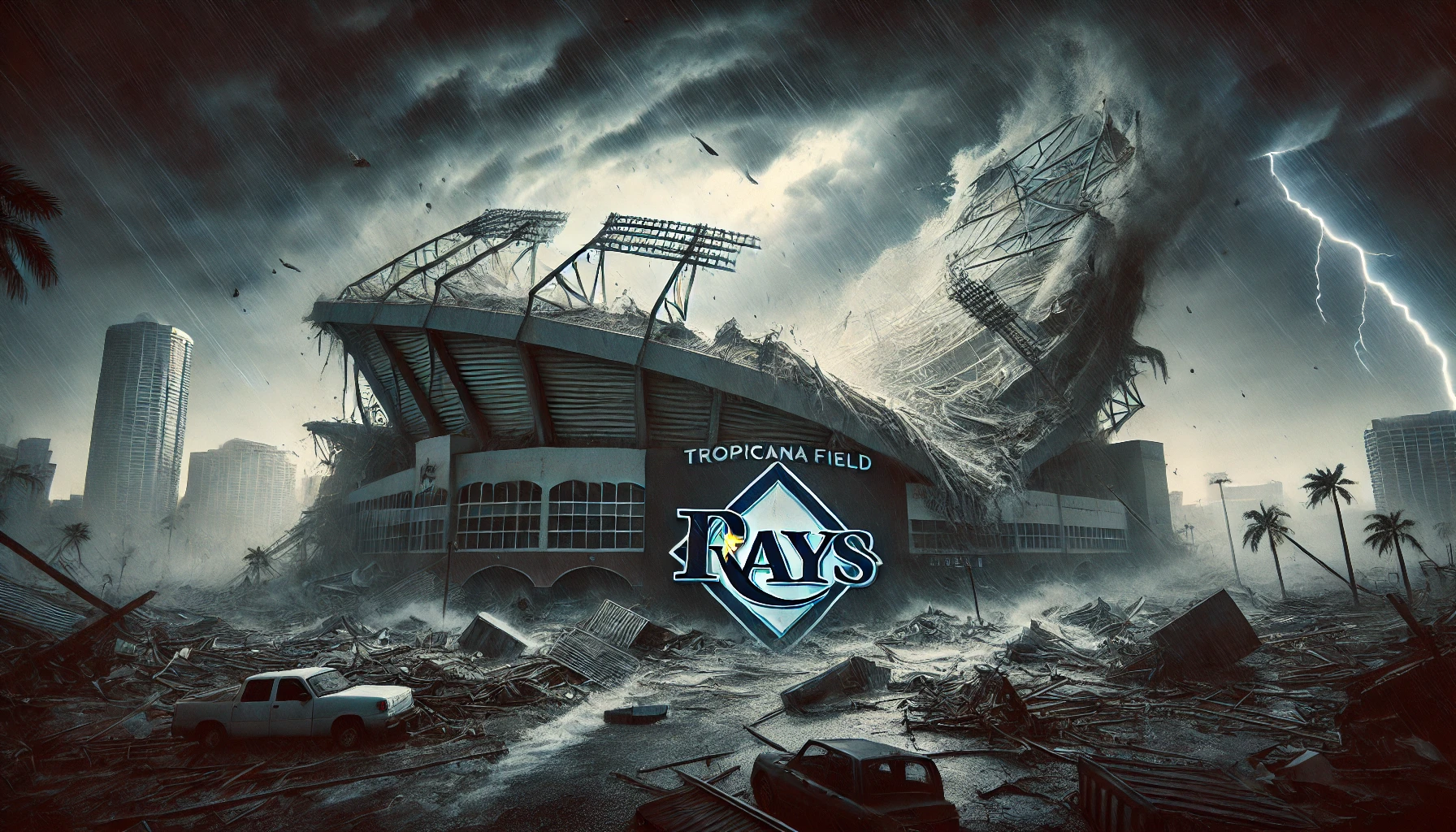Hurricane Milton’s Devastating Impact: How Tropicana Field’s Roof Was Torn Apart by the Storm
Tropicana Field, the home of the Tampa Bay Rays, has long stood as a fortress for baseball fans in Florida. However, the recent devastation caused by Hurricane Milton left the stadium significantly damaged, sparking concern among fans and players alike. The Tropicana Field damage was so severe that parts of the stadium’s roof were ripped off by the hurricane’s powerful winds, marking one of the most dramatic moments in the stadium’s history.
In this blog, we’ll explore how Hurricane Milton impacted Tropicana Field, the response from the Tampa Bay Rays announcer, and the future of the stadium as the team and city work to recover.
Tropicana Field Roof Ripped Off by Hurricane Milton
The most significant damage to Tropicana Field occurred when the stadium’s roof was ripped off by the high winds of Hurricane Milton. As the Category 3 hurricane made landfall on the west coast of Florida, Tropicana Field, which had served as a base camp for first responders during the storm, saw its roof suffer catastrophic damage(Sporting News).
Tropicana Field’s roof was designed to withstand winds up to 115 mph, but Hurricane Milton’s intensity proved too much, with winds reaching over 130 mph. Footage quickly surfaced on social media, showing large sections of the roof being torn apart and debris flying across the stadium. The damage has left many wondering about the future of the stadium, especially as it was being used for emergency efforts during the storm.
What Caused the Roof to Fail?
When Tropicana Field’s roof ripped off, experts pointed to the age of the stadium and the extreme force of Hurricane Milton as contributing factors. Built in 1990, Tropicana Field has seen its share of storms, but Hurricane Milton’s force exceeded the design limitations of the structure. The roof’s failure wasn’t due to neglect but rather the overwhelming strength of the hurricane, which caught many by surprise.
In recent years, there have been discussions about modernizing Tropicana Field, and this event may accelerate those conversations as both the Tampa Bay Rays and local authorities assess the damage and explore solutions.
The Role of Tropicana Field as a Shelter During the Storm
During the hurricane, Tropicana Field was being used as a shelter for power company crews and emergency responders who were working tirelessly to assist the local community(Sporting News). Thankfully, no one was injured when the roof was torn off, as the crews had already been evacuated before the worst of the storm hit.
The decision to use Tropicana Field as a base camp was a critical one, as it allowed for rapid response efforts across the state. However, the extent of the Tropicana Field damage has left the stadium in a vulnerable state, raising questions about whether it can continue to serve as a storm shelter in the future.
Tampa Bay Rays Announcer Dewayne Staats Describes the Devastation
As news of the storm damage spread, longtime Tampa Bay Rays announcer Dewayne Staats was among the first to comment on the situation. Known for his passionate commentary during Rays games, Staats painted a somber picture of the destruction, describing the scene at Tropicana Field as “heartbreaking” for both fans and the organization(Sporting News).
In a statement following the storm, Staats noted, “Tropicana Field has been the heart of baseball in Tampa Bay for decades, and seeing it suffer such devastating damage is hard to process.” Staats also praised the first responders who had been using the stadium as a base camp and emphasized the importance of rebuilding the stadium to ensure it remains a staple in the community.
Impact on the Tampa Bay Rays Organization
For the Tampa Bay Rays, the damage to Tropicana Field represents more than just a structural issue—it’s an emotional blow for the team and its fans. As one of the few domed stadiums in Major League Baseball, Tropicana Field has been a symbol of resilience for the Rays, protecting players and fans from Florida’s unpredictable weather.
The organization has already begun assessing the extent of the damage and what it will take to repair or possibly renovate the stadium. In the meantime, the Rays are exploring alternative locations for future games as they await updates on Tropicana Field’s condition.
The Future of Tropicana Field After the Hurricane
As recovery efforts continue in the aftermath of Hurricane Milton, questions remain about the future of Tropicana Field. The roof damage is extensive, and repairs will likely be costly. While the stadium is still structurally sound, the roof’s failure has raised concerns about its long-term viability.
Options for Rebuilding or Renovating the Stadium
One possibility is that the Tampa Bay Rays and the city of St. Petersburg could use this opportunity to pursue long-discussed plans for a new stadium. Prior to the hurricane, there had already been talks about relocating or renovating Tropicana Field, and the damage may expedite those discussions.
Alternatively, the city and the team could focus on repairing the roof and reinforcing the structure to better withstand future storms. Given Florida’s susceptibility to hurricanes, any renovations would need to account for the possibility of stronger storms in the future.
MLB Stadiums and Hurricane Damage: A Broader Issue
Tropicana Field is not the first Major League Baseball stadium to suffer hurricane damage, and it likely won’t be the last. MLB stadium hurricane damage has become a more common concern as climate change intensifies the frequency and strength of storms. Stadiums in coastal areas like Miami, Houston, and Tampa Bay are particularly vulnerable during hurricane season.
Other MLB Stadiums Affected by Hurricanes
In 2017, Minute Maid Park in Houston sustained minor damage from Hurricane Harvey, although the stadium’s retractable roof helped minimize the impact. Similarly, Marlins Park in Miami has experienced damage during previous hurricanes, though it too has a retractable roof designed to withstand heavy winds.
For the Tampa Bay Rays, the situation is more complex. Tropicana Field’s roof, while strong, is now over three decades old, and it doesn’t have the same modern features that newer stadiums boast. This leaves the Rays facing difficult decisions about the future of their ballpark and how to better protect it from future hurricanes.
Rebuilding After the Storm
The damage to Tropicana Field caused by Hurricane Milton has left a lasting impact on the Tampa Bay Rays and their fans. As the team assesses the extent of the damage and begins the process of rebuilding, the focus will shift to ensuring that the stadium is better prepared for future storms. With discussions about modernization already underway, the devastation may serve as a catalyst for significant changes to Tropicana Field.
In the meantime, the Rays remain resilient, looking ahead to the future while working to restore their iconic ballpark.
For more insights on stadium renovations and the impact of natural disasters on sports venues, explore additional articles at Regent Studies.




